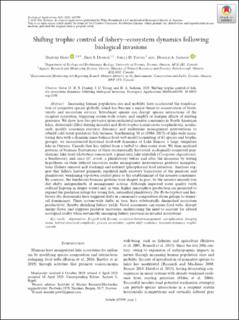| dc.description.abstract | Increasing human population size and mobility have accelerated the translocation of nonnative species globally, which has become a major threat to conservation of biodiversity and ecosystem services. Introduced species can disrupt species interactions of the recipient ecosystem, triggering system‐wide events, and amplify or dampen effects of existing pressures. We show how two pervasive intercontinental invasive consumers in North American lakes, dreissenids (filter‐feeding mussels) and Bythotrephes (carnivorous zooplankton), nonlinearly modify consumer–resource dynamics and undermine management interventions to rebuild cold‐water predatory fish biomass. Synthesizing 30 yr (1986–2015) of lake‐wide monitoring data with a dynamic mass‐balance food‐web model (consisting of 61 species and trophic groups), we reconstructed historical food‐web dynamics of Lake Simcoe, a large, temperate lake in Ontario, Canada that has shifted from a turbid to clear‐water state. We then analyzed patterns of biomass fluctuations of three recreationally harvested, ecologically connected populations; lake trout (Salvelinus namaycush , a piscivore), lake whitefish (Coregonus clupeaformis , a benthivore), and cisco (C. artedi , a planktivore) before and after the invasions by testing hypotheses on their delayed recoveries under management interventions–predator manipulations (fishery removal and stocking) and nutrient (phosphorus) load reduction. Analyses suggest that fishery harvest primarily regulated early recovery trajectories of the piscivore and planktivore, weakening top‐down control prior to the establishment of the invasive consumers. By contrast, the benthivore biomass patterns were shaped, in part, by the invasive mussels (via diet shift), independently of management actions. Although improved water quality (with reduced hypoxia in deeper water) and, in turn, higher macrophyte production are projected to expand the predation refuge for young fish, intensified planktivory (by Bythotrephes ) and herbivory (by dreissenids) have triggered shifts in community composition (from pelagic to demersal dominance). These system‐wide shifts, in turn, have substantially diminished ecosystem productivity, thereby shrinking fishery yields. Novel consumers can rewire food webs, disrupt energy flows, and suppress predator recoveries, underscoring the need to account for altered ecological reality when sustainably managing fishery resources in invaded ecosystems. | |
